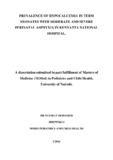| dc.description.abstract | Introduction: Perinatal asphyxia is a common neonatal problem that contributes
significantly to neonatal morbidity and mortality. It is a multi-organ disorder and some of
it’s’ complications include cerebral palsy, organ dysfunction, hematologic disorders and
metabolic disorders e.g. hyponatremia, hypocalcemia. Hypocalcemia in neonates is a major
concern especially in those who have suffered perinatal asphyxia. This is because some of the
clinical features of hypocalcemia e.g. jitteriness, seizures cannot be differentiated from the
presentation of hypoxic ischemic encephalopathy.
Justification: Perinatal asphyxia is a common finding in our set up and it is associated with a
very high mortality. Few studies have shown an occurrence of hypocalcemia in neonates with
asphyxia; however, there’s no local study done to determine the prevalence of hypocalcemia
in neonates with asphyxia. In addition, it is vital to know exactly what an asphyxiated
neonate is suffering from so as to initiate the right treatment and prevent further
complications. Results from this study will help health workers make informed decisions on
management of neonates with perinatal asphyxia.
Objectives: The objective was to determine the prevalence of hypocalcemia in term neonates
with moderate and severe perinatal asphyxia in KNH and compare it to the prevalence of
hypocalcemia in term neonates without asphyxia in KNH.
Study Setting: Newborn Unit and Maternity Ward in Kenyatta National Hospital.
Study Population: Term neonates admitted with Stage 2 or 3 encephalopathy as per Sarnat
and Sarnat Staging made up the cases while the control group consisted of normal, term
neonates whose gestational ages and weight were matched.
Study Procedure: Cases selected were term neonates with a poor Apgar score of less than 8
at the 5th minute who were further scored using Sarnat and Sarnat staging while controls
were normal,healthy,age and weight matched term neonates from KNH maternity ward.
Methodology: The prevalence of hypocalcemia between neonates with asphyxia and normal
neonates was compared using a case control study design which was carried out over a period
of three months, from April to May 2016.
The cases, chosen using non randomized consecutive sampling were term neonates admitted
to NBU while the controls were age and gender matched term neonates who were delivered
without complications in KNH maternity. The study was carried out until the required sample
size of 138 neonates was achieved.
Cases and controls were identified using a predetermined inclusion and exclusion criteria.
Neonates were also staged using Sarnat and Sarnat staging criteria. Informed consent was
then obtained from the mothers following which calcium blood samples were drawn.
Laboratory results were availed to the primary clinicians as soon as they were ready.
Neonates with hypocalcemia received calcium supplementation. Data was entered into SPSS
version 20.
Standard statistical procedures were used to summarize study findings and results were
presented in tables, charts and figures. Continuous variables were summarized using
measures of central tendency and dispersion while categorical variables were summarized
using frequency tables.
Results: The study population consisted of a total of 138 term neonates; 69 asphyxiated and
69 normal term neonates. The mean gestational age was 39 weeks with the asphyxiated term
neonates having a higher mean calcium level, 2.20 compared to a mean of 2.04 found in
normal neonates. All the normal term neonates were in Sarnat and Sarnat stage 0 while in the
asphyxiated group, 61 (93.6%) had Sarnat and Sarnat stage 2 encephalopathy and 8 (6.4%)
had stage 3 encephalopathy. In the asphyxiated group, 24 (38.1%) of the neonates had
convulsions. Most of the deliveries, 99 (78.2%) were conducted at Kenyatta National
Hospital with 25 (39.7%) vaginal deliveries and 38 (60.3%) cesarean deliveries in the control
group and 46 (71.7%) vaginal deliveries and 7 (11.7%) cesarean deliveries in the cases group.
Most of the neonates 46 (71.70%), delivered by SVD had asphyxia. The prevalence of
hypocalcemia in term neonates with perinatal asphyxia was 28.8% in comparison to 1.4%,
the prevalence found in term neonates without asphyxia. Term neonates with perinatal
asphyxia were 10 times more likely to have hypocalcemia compared to term neonates without
asphyxia. The severity of the level of asphyxia based on Sarnat and Sarnat staging is
associated with a higher risk of developing hypocalcemia. In addition, the term neonates with
convulsions were seven times more likely to have hypocalcemia in comparison to term
neonates with no convulsions.
Conclusion: The prevalence of hypocalcemia in term neonates with perinatal asphyxia was
28.8%; with the odds of having hypocalcemia being 26.5 (95% CI of 3.4 – 206.7). In
comparison, the prevalence of hypocalcemia in normal neonates was 1.4%. Obstetric factors
e.g. place and mode of delivery was found to have a positive association with hypocalcemia.
Recommendations: All asphyxiated neonates should have their calcium levels monitored.
Neonates with convulsions should also have their calcium levels monitored. | en_US |
| dc.description.department | a
Department of Psychiatry, University of Nairobi, ; bDepartment of Mental Health, School of Medicine,
Moi University, Eldoret, Kenya | |



